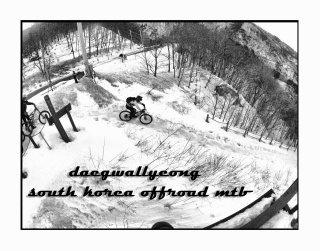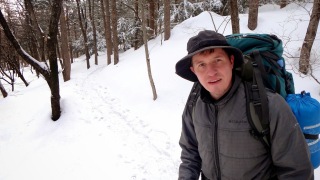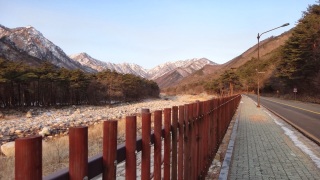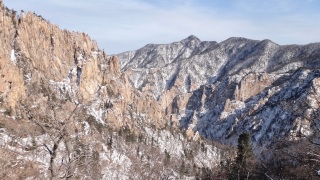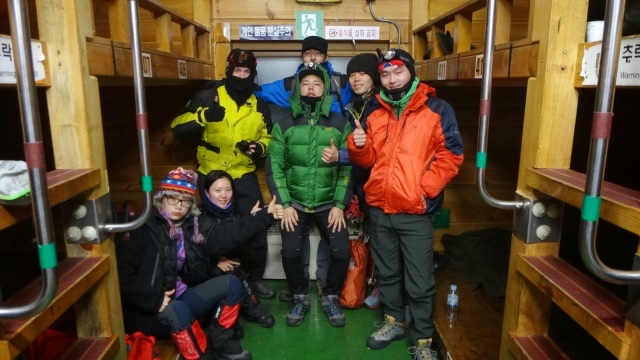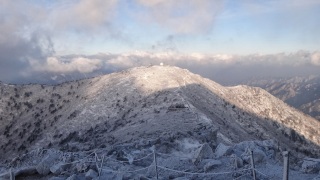How do you start off on a microadventure?
Well, it’s easy. Pack your lightweight backpack with extra shirts, wear merino wool base layers in winter that keep you warm and dry easily, and remember to take a pot/lid, cook stove (butane is good), noodles, tuna can, nuts, raisins and 3-4 liters of water for two people.
Where did our overnight microadventure begin?
We started this adventure from my apartment in Gangneung City, Gangwon-do, South Korea. We walked for 10 minutes to the Gangneung Express Bus terminal, and bought 2,500 Korean won tickets to Hoenggye village near YongPyong 2018 Olympic ski area in Pyeongchang county.
Daniel Bissell is my guest for this trip and together we make a great microadventure team for spring trekking in South Korea. We hiked for two half days and completed about 7 hours of walking along a 20km course from Hoenggye village, Pyeongchang county back into the Pine City in Gangneung, Gangwon-do.


My friend and colleague Daniel Bissell decided on a winter microadventure weekend S24O (Sub-24 hour Overnight) trek through Daegwallyeong via Hoenggye and Gangneung, South Korea. We started out on a Thursday afternoon from Gangneung City, Gangwon-do Express Bus terminal, we took a 20 minute bus ride over the Taebaeksan coastal mountain range between the 2018 Winter Olympic region of Pyeongchang county to Hoenggye village.. Express bus tickets can be purchased on location (2,500 Korean won) one-way for Hoenggye village. Once inside the small town, it’s a relatively easy walk through town, past bakeries and convenience stores for your fresh bread and hot coffee (GS Mart is just Southeast of the Bus Terminal, walk towards the Taebaek Mountains).
There are a series of small rural roads that will connect with Highway 456 and the official starting point of the trail head. We used to DH mountain there in 2011 with Ahn Daegi from Gagneung Bike Mart, but the trail has officially closed to mountain biking since it’s shared with hikers and trekking groups. It’s a quiet trail. This is nothing like Bukansan Mountain in northern Seoul or Seoraksan Mountain trekking S24O in Sokcho-dong. There are also many Korean national parks to choose from, each geographical location and trail network is quite unique to explore.

I have had several previous Microadventures in South Korea, including the Mountain Cougar (Puma) crossing Microadventure S24O. In autumn, you can see the colors changing on the deciduous trees, on this 24-hour mountain bike microadventure I met up with a mother Cougar or mountain puma while cycling from Gangneung on Daegwallyeong Highway 456 and south through the Taebaeksan Mountains on Highway 6/59 South from Jinbu village. On the southbound two-lane highway through a beautiful mountain plateau, I passed small farms and followed the Odaecheon river. Gangwon Province’s Taebaeksan mountains are located in a northeast region of South Korea with 1000 meter+ peaks and colorful forests, mountain streams with cascading waterfalls with extensive hiking trails and Korean national parks dedicated to free public usage.
Mountain bike microadventures (Puma Crossing)
On the Daegwallyeong trail we immediately found a hard snow pack which made the hike relatively easy.
Gangwon-do is well known for it’s pine forests, we walked through many of those small forests.
Open spaces for clearing your thoughts, burning calories, relaxing in nature, one with the surroundings.
Looking through a fence outside the Sheep farm, a beautiful open range looking west towards Hoenggye.
Icicles and pine trees budding, it’s almost spring here.
Oh winter, loving the trail hikes in Korea!
We walked up the service road and examined the military surveillance station closed to the public.
Local hiking clubs visiting the Daegwallyeong trail leave their pennants.
Koreans put park benches along the hiking trail, just where you need them.
The Daegwallyeong trail crosses over Freeway-Highway 65 connecting Sokcho City and the southern cities
Our microadventure was simple. We decided to Express Bus to Hoenggye village (2,500won) and hike back down Daegwallyeong trail (parallel to Old Daegwallyeong Highway 456) and along this route we had great views of the adjacent mountains, streams flowing. The sights and sounds were relaxing.
We rounded out the day with a dinner of vegetarian delight, some ramen noodles, Daniel prepared the chili bean sandwiches on whole wheat bread, and the chili bean can itself was used as a warming cup for hot coffee. We enjoyed dinner past sunset and decided to continue through hiking to a local public
Bathhouse Sauna (Jimjilbang) located along
Old Daegwallyeong Highway 456 west of Gangneung. When visiting Korea, always remember to visit a Jim-Jil-Bang bathhouse. This location charges 7,500 Korean won for Gangneung residents, blankets are rented for 1,000 Korean won.
Daniel spoke Korean and asked to kept our backpacks behind the
public sauna’s (Jim-jil-bang) front desk. After a good soak in the spa, hot rooms, and cave rooms (very very hot dry sauna) we asked for another set of shirts and shorts (a uniform rented by the sauna) to sleep in. They have mats and rectangular vinyl pillows available to sleep on, they are always free to use in South Korea.
A Jimjilbang (Hangul: 찜질방; hanja: -房) is a large, gender-segregated public bathhouse in Korea, furnished with hot tubs, showers, Korean traditional kiln heated saunas.
Need a
microadventure idea of your own? (: Thank you for visiting the Korean world.






